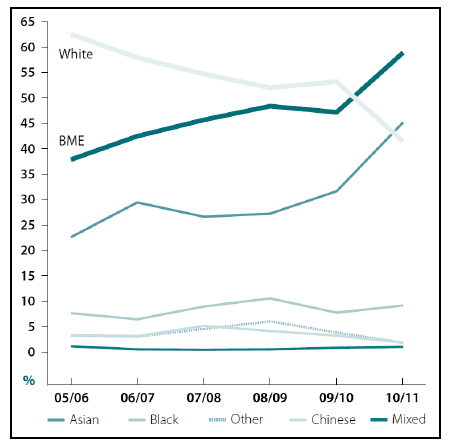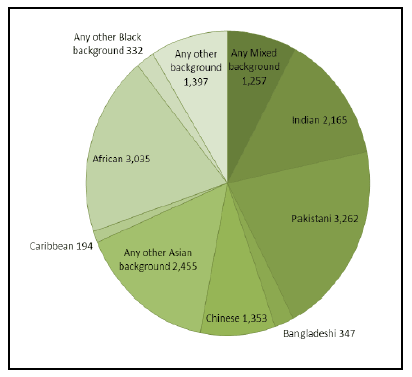Scottish Government Equality Outcomes: Ethnicity Evidence Review
This evidence review was prepared to support the production of the Scottish Government's Equality Outcomes, with regard to ethnicity.
4 Further and Higher Education
4.1 This section discusses the ethnic composition of the student population, subject choice, levels of attainment, and workforce composition.
4.2 Where possible, the data are broken down for further education and higher education.
Composition of the student population
4.3 According to Scottish Government data for 2009/10, students who declared their ethnicity to be white constituted 82% of all students. Students who declared their ethnicity to be Chinese were the second largest ethnic group (2% of the total) and those who declared their ethnicity to be Indian were the third largest ethnic group (1.8% of all students)29. The Equality Challenge Unit30 tracks the profile of students by ethnicity over time, and distinguishes between those who are and are not domiciled in the UK. Changes to the ethnic profile were most prominent within the non-UK domiciled group (see Figure 3), though the number of students within this group remains small. Since 2005/06, the proportion of white students in this group has fallen by 21.0%, while the proportion of Asian students has increased by 22.5%. The proportion of ethnic minority students within the non-UK domiciled group has increased from 37.7% in 2005/06 to 58.7% in 2010/11. In comparison, the ethnic profile of UK-domiciled students has remained fairly static.
Figure 3: Non-UK domiciled students by ethnicity (Source: Equality in Colleges in Scotland: Statistical Report 2012)

4.4 The Scottish Funding Council reports that in further education the proportion of ethnic minority students in 2010/11 was 4.8%, with African and Pakistani students being the largest ethnic minority groups31 (see Figure 4).
Figure 4: Ethnic background of minority student groups, 2010-11 (Source: College Performance Indicators 2010-11)

Subject choice
4.5 The Equality Challenge Unit reports that higher education students of certain ethnicities are more concentrated in some subjects than others. For example, 20.3% of black students and 22.5% of Asian students study engineering and technology, compared with between 10.0% and 12.8% of students of other ethnicities. More than half (53.3%) of all Asian students study business and administrative studies. 27.2% of mixed students and 18.5% of white students study creative arts and design, compared with 4.9% of black students and 4.6% of Asian students.
Attainment
4.6 The Equality Challenge Unit explores the level of study by students across all ethnic groups within further education, and finds that there are considerable variations by level in the Scottish Credit and Qualifications Framework. For example, a higher proportion of Chinese students are studying at level 3 (Foundation Standard Grade) than other ethnic groups, with 9.5% studying at this level compared with 1.0% of white students. A higher proportion of ethnic minority students study at higher education level overall (22.2%) than white students (13.4%). Most starkly, 16.0% of all Asian students study at level 8 (e.g. for a Diploma of Higher Education) compared with 5.5% of white students.
4.7 The Equality Challenge Unit reports that, at higher education level, the proportion of students completing their course is highest among black students (84.0%) and lowest among mixed students (80.4%). At further education level, the proportion of students completing their course is highest among white students (88.9%) and lowest among Chinese students (82.9%).
4.8 The Scottish Government's analysis of the Annual Population Survey 2010 reports that degrees are held by 32% of ethnic minority people, versus 20% of all white people32.
4.9 The EHRC Triennial Review reports on further education for the UK as a whole. Students from different ethnic minority groups have different outcomes when studying for their first degree, with students from some ethnic minority groups far less likely to leave university with a first or upper second class degree than others. For example, in 2008/09 white students were most likely to achieve this level, with nearly 7 in 10 (67%) white students leaving with a first or upper second class degree, compared to just under 4 in 10 black students (38%).
Workforce composition
4.10 A report on diversity in the further education workforce33 found it to be predominantly white, as shown in Table 4. This report found little evidence of ethnic minority staff in promoted posts, and overall the low numbers of ethnic minority staff was concerning staff at all levels.
Table 4: Staff by ethnic group and type of role (Source: Equality and Diversity in the Further Education Workforce, undated)
| Ethnic Group | FTE | |||
|---|---|---|---|---|
| Teaching | Non-teaching (support) | Total | ||
| White | Scottish | 5,256 | 5,166 | 10,422 |
| English | 465 | 307 | 772 | |
| Welsh | 30 | 12 | 42 | |
| Irish | 63 | 46 | 108 | |
| Any other white background | 347 | 280 | 627 | |
| Mixed | Any mixed background | 17 | 11 | 28 |
| Asian, Asian Scottish or Asian British | Indian | 13 | 11 | 24 |
| Pakistani | 5 | 5 | 11 | |
| Bangladeshi | 2 | 3 | 5 | |
| Chinese | 5 | 12 | 18 | |
| Any other asian background | 3 | 13 | 16 | |
| Black, Black Scottish or Black British | Caribbean | 5 | 3 | 8 |
| African | 8 | 4 | 12 | |
| Any other black background | 3 | 6 | 9 | |
| Other ethnic background | Any other background | 17 | 10 | 27 |
| Information refused / not known | 190 | 142 | 332 | |
| Total | 6,430 | 6,030 | 12,460 | |
Contact
Email: Social Research
There is a problem
Thanks for your feedback